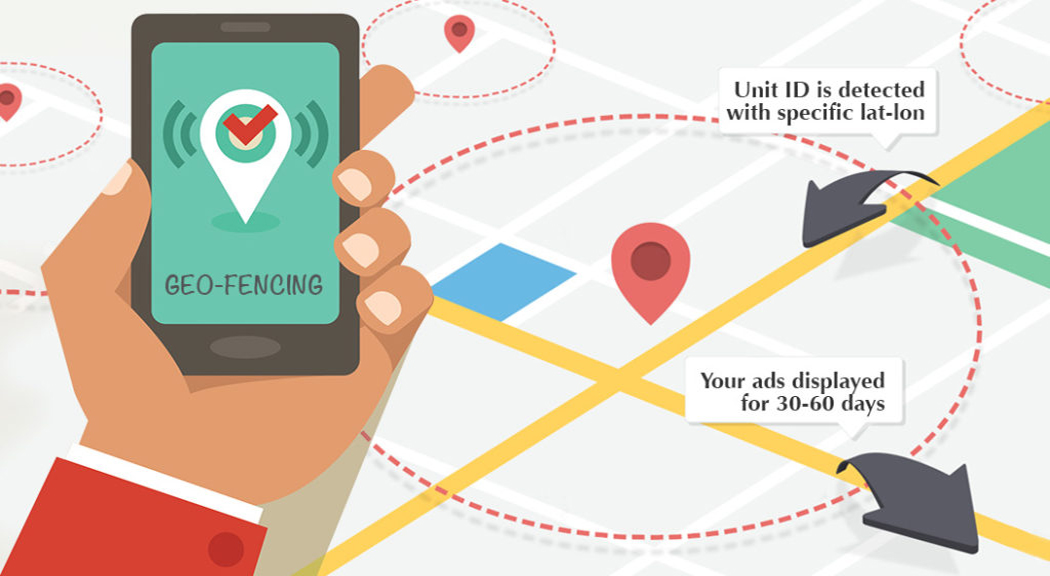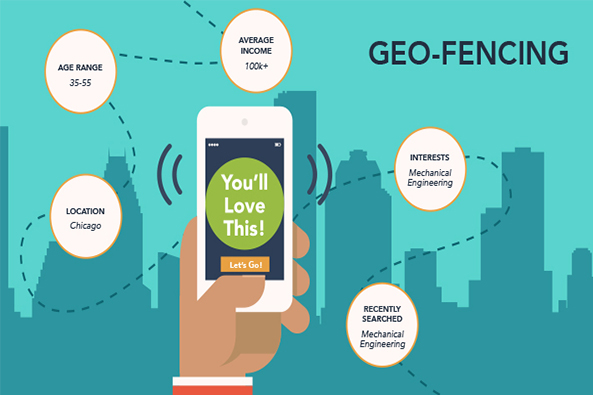GEOFENCING MARKETING

Geofencing and GeoTargeting are location-based services where an app, browser or other technology service uses location data such as cellular data, Wi-Fi, global positioning (GPS), satellite, radio frequency identification (RFID), when a device, transmitter, or RFID tag enters or leaves location parameters commonly known as a geofence, location target or geotargeting. Once this “location boundary” is set, the location information can be used to trigger a programmed action such as push notifications, SMS message, alerts, display targeted advertising, allow tracking on vehicle fleets, enable/disable certain equipped technologies, or create and collect location-based marketing data. Geofencing and geotargeting are commonly used in online advertising / online marketing as well as other tracking and location services.
Some geofences may simply be set up to monitor activity in certain areas, which alerts when anyone enters or leaves a specific area. Businesses can also use geofencing to monitor employees on or off the work site, automate time cards, or to maintain awareness of company property.
HOW DOES GEOFENCING AND GEO TARGETING ACTUALLY WORK IN MARKETING AND ADVERTISING?

Geofencing and GeoTargeting are location-based services where an app, browser or other technology service uses location data such as cellular data, Wi-Fi, global positioning (GPS), satellite, radio frequency identification (RFID), when a device, transmitter, or RFID tag enters or leaves location parameters commonly known as a geofence, location target or geotargeting. Once this “location boundary” is set, the location information can be used to trigger a programmed action such as push notifications, SMS message, alerts, display targeted advertising, allow tracking on vehicle fleets, enable/disable certain equipped technologies, or create and collect location-based marketing data. Geofencing and geotargeting are commonly used in online advertising / online marketing as well as other tracking and location services.
Some geofences may simply be set up to monitor activity in certain areas, which alerts when anyone enters or leaves a specific area. Businesses can also use geofencing to monitor employees on or off the work site, automate time cards, or to maintain awareness of company property.
USE OF GEOFENCING MARKETING
- Geofencing is a very powerful way to engage consumers based on “hyper-local” location, which could do a lot in terms of triggering immediate sales if set up properly, as well as collecting data to understanding the mindset of different shoppers.
- Geofencing campaigns can be set up across multiple types of online advertising campaigns, such as search engine advertising, display advertising, remarketing, video advertising, etc.
- An auto dealer could set up a geofence which is aimed at targeting individuals who are leaving a competing dealership after browsing for a vehicle. If this auto dealer sends a direct message to them with an offer for zero percent financing on a comparable car model, the customer may be very likely to continue their browsing at the advertised location since the deal addressed a particular need they had at the time.
- Concert and events producers can geofence their venues for art or music events with additional offers for upcoming events which may be relevant to the attendee. Artists and musicians and their managers could also establish geofences around different tour stop ahead of time, promoting upcoming shows for those who are likely to revisit the location. This same process could be used to collect data about people within the geofenced area to understand the mindset of the attendees to predict and prepare future event turnouts.
- An attorney, lawyer, or law firm could set up a geofencing advertising campaign to target specific areas of interest such as hospitals or jails to reach their target client. They could also set up geo-targeting around competitor locations. Also, take a look at these Law firm and Lawyer Marketing Ideas.
- Even if a geofenced offer, advertisement, or notification doesn’t actually inspire an immediate visit or a sale, it still can allow business owners to know exactly what location a consumer passed through and where they were when they received the message. This very user-specific data should help in refining targeting efforts in the future based on which types of communications and targeted users were the most successful.
